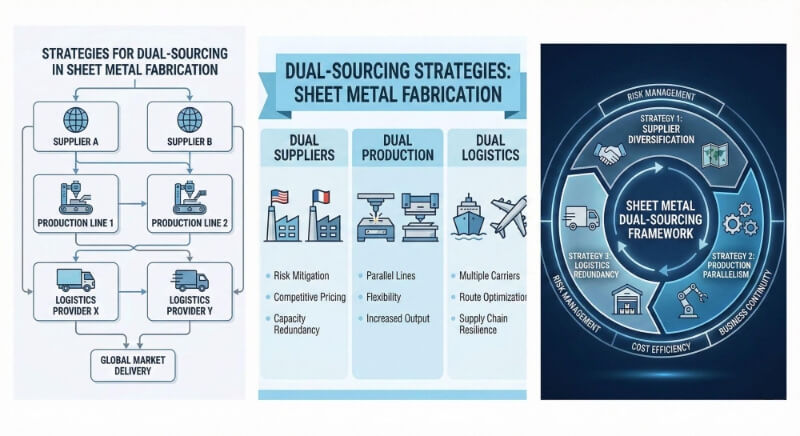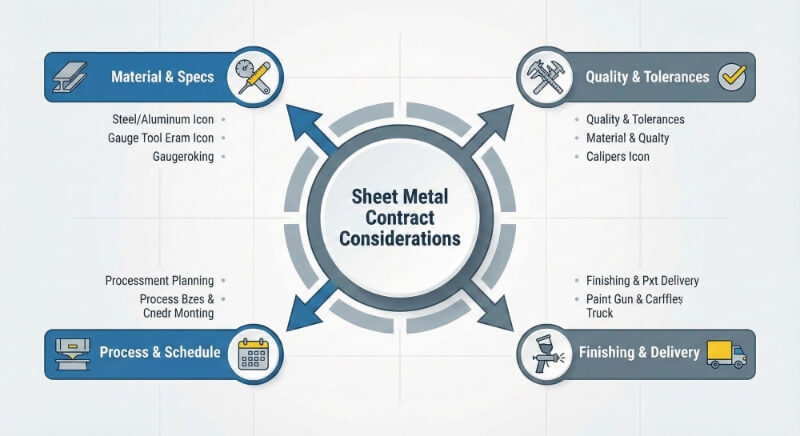모든 제작 프로젝트는 접합 단계에서 중요한 결정에 직면합니다. 잘못된 방법을 선택하면 재료 낭비, 비용 증가, 프로젝트 지연으로 이어질 수 있기 때문에 금속 제조업체는 종종 점용접과 스폿 용접을 놓고 고민합니다. 각 기술은 금속 제작에서 고유한 목적을 가지고 있지만, 많은 전문가들은 자신의 요구에 가장 적합한 접근 방식을 결정하는 데 도움이 필요합니다.
이 두 가지 용접 기술은 금속 제작에서 서로 다른 용도로 사용됩니다. 점 용접은 최종 용접 전에 부품을 제자리에 고정하기 위해 임시 조인트를 만드는 반면, 스폿 용접은 전기 저항을 통해 금속 시트를 영구적으로 융합합니다. 각 방법은 특정 애플리케이션에 고유한 이점을 제공합니다.
이 두 가지 용접 기술을 자세히 비교해 보겠습니다. 주요 차이점, 이상적인 애플리케이션, 실용적인 고려 사항을 살펴보고 다음 프로젝트를 위한 정보에 입각한 결정을 내리는 데 도움이 될 것입니다.
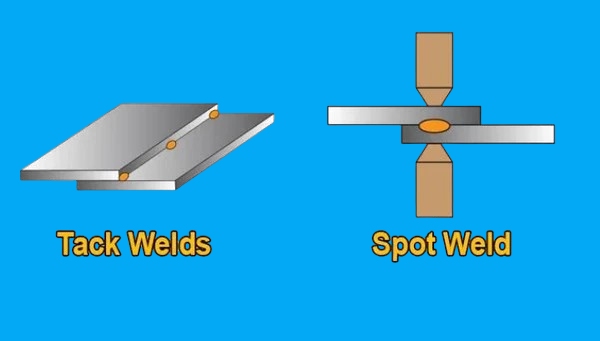
점착 용접의 기초
압정 용접의 중추를 형성하는 정밀한 금속 조립. 이 예비 용접 단계는 최종 용접 과정에서 정렬을 유지하는 임시 고정점을 만듭니다. 이 기술의 핵심적인 측면을 살펴보겠습니다.
점착 용접이란?
점착 용접 은 금속 조각을 제자리에 고정하기 위해 작은 임시 용접을 만듭니다. 이 짧은 용접은 재봉 프로젝트에서 핀과 같은 역할을 하여 최종 용접까지 모든 것을 정렬합니다. 이 프로세스는 부품 위치를 유지하기에 충분히 강력한 결합을 생성하는 동시에 조정이 필요한 경우 쉽게 제거할 수 있습니다.
금속 제조에서 점착 용접의 목적
점착 용접은 주 용접 공정 중 부품의 이동을 방지합니다. 이 기술은 복잡한 어셈블리나 긴 이음새로 작업할 때 매우 유용합니다. 적절한 압정 배치는 치수 정확도를 유지하고 최종 제품의 왜곡을 줄입니다.
점착 용접에 사용되는 기술
전문 용접사는 열 분배를 제어하기 위해 전략적인 지점에 압정 용접을 배치합니다. 이들은 일반적으로 조인트 라인을 따라 중앙에서 바깥쪽으로 작업하면서 압정을 균일하게 배치합니다. 압정의 크기와 개수는 재료 두께와 조인트 길이에 따라 달라집니다.
점착 용접의 장점
택 용접은 최종 용접 전에 부품 위치 및 조립 확인을 정밀하게 수행할 수 있습니다. 이 방법은 핏 확인 및 조정이 가능하여 재료 낭비를 줄여줍니다. 또한 택 용접은 공작물 전체에 열을 고르게 분산시켜 뒤틀림을 제어하는 데 도움이 됩니다.
점착 용접의 한계와 단점
이 프로세스에는 최종 용접에 약한 부분이 생기지 않도록 하는 기술이 필요합니다. 압정 배치를 잘못하면 결함이나 뒤틀림이 발생할 수 있습니다. 이 추가 단계는 제작 공정에 시간을 추가하지만, 일반적으로 이러한 투자는 품질 향상을 통해 보상을 받습니다.
스폿 용접의 기초
스폿 용접 는 자동차 및 제조 산업에 혁명을 일으켰습니다. 이 전기 저항 용접 공정은 집중된 열과 압력을 통해 금속판 사이에 강력하고 영구적인 접합부를 생성합니다.
스폿 용접이란?
스폿 용접은 금속판 사이의 특정 지점에 압력과 전류를 가하여 영구적인 접합부를 만듭니다. 이 공정은 추가 필러 금속 없이 제어된 위치에서 재료를 녹여 융합합니다. 이 자동화된 방법은 몇 초 만에 일관된 고강도 연결을 생성합니다.
스폿 용접은 어떻게 작동합니까?
두 개의 구리 전극이 높은 전류를 전도하면서 금속 조각을 서로 누릅니다. 금속의 자연 저항은 접촉 지점에서 강한 열을 발생시킵니다. 압력을 받으면 이 열이 용융된 덩어리를 만들어 강력한 금속 결합으로 굳어집니다.
스폿 용접에서 전기 저항의 역할
전기 저항은 전류 흐름을 용접 지점에서 집중된 열로 변환합니다. 금속의 저항 특성에 따라 필요한 전류 및 타이밍 설정이 결정됩니다. 재료마다 최적의 용접 강도를 달성하기 위해 특정 매개변수를 조정해야 합니다.
스폿 용접의 응용
자동차 제조업체는 차체 조립에 스폿 용접을 광범위하게 사용합니다. 이 기술은 가전 및 전자제품의 판금 부품을 접합하는 데 탁월합니다. 생산 라인은 대량 작업에서 속도와 일관성을 위해 스폿 용접에 의존합니다.
스폿 용접의 장점
이 프로세스는 자동화에 이상적인 빠르고 반복 가능한 결과를 제공합니다. 충전재가 없어 소모품 비용이 절감됩니다. 깔끔한 용접은 최소한의 마감 작업만 필요합니다. 최신 스폿 용접 시스템은 용접 파라미터를 정밀하게 제어할 수 있습니다.
스폿 용접의 한계와 단점
스폿 용접은 특정 금속 조합과 두께에 가장 적합합니다. 초기 장비 비용은 기본 용접 도구보다 높습니다. 공작물의 양면에 접근해야 하므로 일부 용도에 제한이 있습니다. 전극 마모로 인해 정기적인 유지보수 및 교체가 필요합니다.
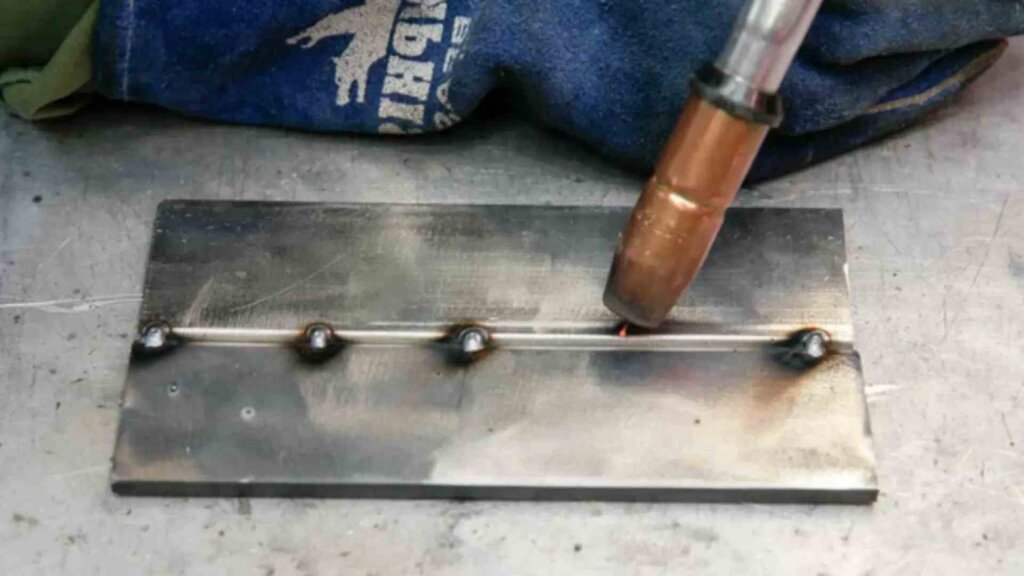
점용접과 점용접 비교: 직접 비교
이러한 용접 방법 중 올바른 선택을 하는 것이 프로젝트 성공에 영향을 미칩니다. 이 비교에서는 의사 결정 과정을 안내하는 주요 요소를 세분화하여 설명합니다.
사용 프로세스 및 장비
점착 용접에는 다음과 같은 표준 아크 용접 장비가 필요합니다. MIG 또는 TIG 기계. 용접공은 수작업으로 작은 임시 조인트를 만듭니다. 스폿 용접에는 구리 전극과 정밀한 전기 제어 시스템을 갖춘 특수 장비가 필요합니다. 매개변수가 설정되면 프로세스가 자동으로 실행됩니다.
재료 호환성
압정 용접은 다양한 두께의 대부분의 용접 가능한 금속에 사용할 수 있습니다. 이 방법은 탄소강, 스테인리스강, 알루미늄에 적합합니다. 스폿 용접은 얇은 판금, 특히 연강 및 아연 도금 재료에서 가장 잘 수행됩니다. 일부 재료 조합은 스폿 용접에 어려움이 있습니다.
용접의 강도 및 내구성
압정 용접은 최종 용접 중에 파손되도록 설계된 임시 고정 장치 역할을 합니다. 강도는 크기와 기술에 따라 다릅니다. 스폿 용접은 일관된 품질을 유지하는 영구적이고 강력한 접합부를 만듭니다. 너겟 크기에 따라 최종 접합 강도가 결정됩니다.
속도와 효율성
점착 용접은 수동 위치 지정과 용접으로 인해 더 많은 시간이 소요됩니다. 각 작업에는 숙련된 용접공의 개별적인 주의가 필요합니다. 스폿 용접은 빠른 결과를 제공하며 종종 몇 초 만에 접합부를 완성합니다. 자동화된 프로세스는 안정적인 생산 속도를 유지합니다.
비용 고려 사항
압정 용접은 일반적인 용접 장비를 사용하지만 숙련된 노동력이 필요합니다. 필러 금속 사용량을 최소화하여 재료 비용이 낮게 유지됩니다. 스폿 용접은 특수 장비에 대한 초기 투자가 더 많이 필요합니다. 자동화를 통해 운영 비용이 절감되고 필러 재료가 필요하지 않습니다.
용접 방법 선택 시 고려해야 할 주요 요소
이러한 용접 방법 중 올바른 선택을 하는 것이 프로젝트 성공에 영향을 미칩니다. 이 비교에서는 의사 결정 과정을 안내하는 주요 요소를 세분화하여 설명합니다.
재료 두께 및 유형
금속 두께에 따라 용접 방법을 선택할 수 있습니다. 택 용접은 두꺼운 판재와 구조 부품을 쉽게 처리할 수 있습니다. 3mm 이하의 얇은 판재는 스폿 용접이 더 효과적입니다. 재료 구성은 용접성에 영향을 미치며 탄소강은 두 가지 방법 모두에 잘 반응하지만 고합금 금속은 특별한 고려가 필요합니다.
생산량 및 워크플로
생산에는 형상 용접 선택이 필요합니다. 소규모 배치 작업은 택 용접의 유연성을 활용할 수 있습니다. 대량 작업은 스폿 용접 자동화를 통해 효율성을 높일 수 있습니다. 워크플로 패턴은 설정 시간과 생산 속도의 트레이드오프에 영향을 미칩니다.
정밀도 요구사항
프로젝트 공차에 따라 용접 결정이 달라집니다. 택 용접을 사용하면 조립 중에 지속적으로 조정할 수 있습니다. 스폿 용접은 프로그래밍된 설정을 통해 일관된 접합 품질을 유지합니다. 복잡한 형상에는 택 용접이 제공하는 제어 기능이 필요합니다.
용접 영역의 접근성
접합 위치는 방법 선택에 영향을 미칩니다. 점용접은 최소한의 장비로 좁은 공간에 도달할 수 있습니다. 스폿 용접은 조인트의 양쪽에 명확하게 접근할 수 있어야 합니다. 방법을 선택할 때는 작업 공간 레이아웃과 부품 형상을 고려하세요.
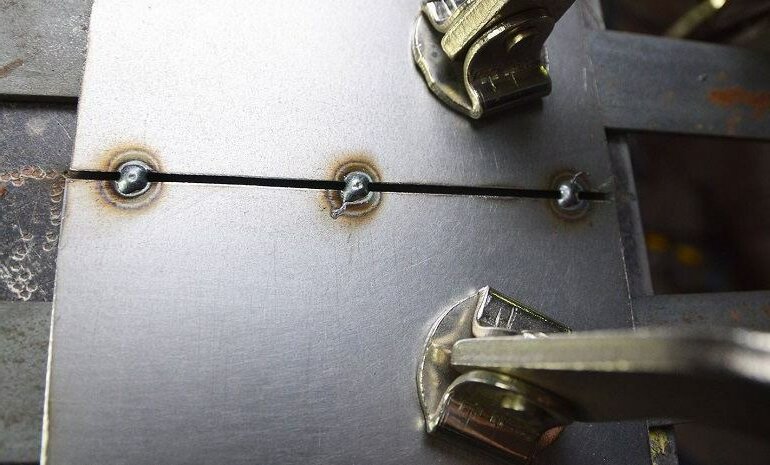
점착 용접 및 스폿 용접에 대한 일반적인 오해
이 섹션에서는 두 가지 용접 방법에 대해 자주 오해하는 내용을 정리합니다. 이러한 오해를 바로잡으면 비용이 많이 드는 실수를 방지하고 금속 제작 작업에서 프로젝트 계획을 개선하는 데 도움이 됩니다.
점착 용접은 영구적이지 않다 - 참인가 거짓인가?
많은 제작자는 최종 용접 중에 점착 용접이 항상 파손된다고 생각합니다. 진실은 기술과 용도에 따라 다릅니다. 강한 점착 용접은 종종 최종 용접 비드의 일부가 되기도 합니다. 숙련된 용접사는 프로젝트의 필요에 따라 점착 강도를 조정합니다. 압정 배치를 잘못하면 최종 접합부가 약해질 수 있습니다.
모든 재료에 스폿 용접이 가능한가요?
이러한 일반적인 믿음은 프로젝트 실패로 이어집니다. 특정 재료 조합과 두께에 적합한 스폿 용접. 이 공정은 열을 발생시키기 위해 적절한 전기 저항이 필요합니다. 구리와 같은 일부 금속은 높은 전도성 때문에 스폿 용접에 저항합니다. 소재를 선택하려면 스폿 용접 호환성에 대한 신중한 평가가 필요합니다.
결론
택 용접과 스폿 용접은 현대 금속 제조에서 중요한 역할을 하며, 각각 작업 현장에 뚜렷한 이점을 제공합니다. 금속 접합의 성공은 작업에 적합한 방법을 선택하는 데서 비롯됩니다.
다용도성 및 실무 제어가 필요한 경우 점착 용접을 선택하세요. 신속하고 자동화된 생산을 위해 스폿 용접을 선택하세요. 프로젝트 요구 사항, 재료 사양 및 생산 목표에 맞게 용접 방법을 선택하세요.
오늘 무료 맞춤 견적 받기
다음 프로젝트를 위한 전문가 엔지니어링 지원
빠른 응답
24시간 이내 견적
DFM 지원
디자인 제작
품질 보증
ISO 9001:2015 인증
최소 주문량 없음
프로토타입에서 생산까지
약정 필요 없음 - 100% 무료 상담
안녕하세요, 저는 케빈 리입니다

지난 10년 동안 저는 다양한 형태의 판금 제작에 몰두해 왔으며 다양한 워크숍에서 얻은 경험에서 얻은 멋진 통찰력을 이곳에서 공유했습니다.
연락하세요

케빈 리
저는 레이저 절단, 굽힘, 용접 및 표면 처리 기술을 전문으로 하는 판금 제조 분야에서 10년 이상의 전문 경험을 갖고 있습니다. Shengen의 기술 이사로서 저는 복잡한 제조 문제를 해결하고 각 프로젝트에서 혁신과 품질을 주도하는 데 최선을 다하고 있습니다.


